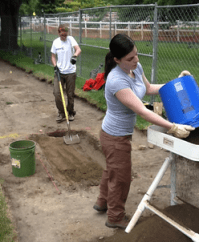My Experience as a Campus Archaeology Tech

This is a blog post by Rachel Cohen; Rachel has been volunteering for Campus Archaeology throughout the summer. She is an undergraduate student from University of Michigan, majoring in archaeology.
While I had some previous experience working with ancient artifacts, this was my first experience with historic artifacts. Most of my time was spent digging Shovel Test Pits (Also known as STPs, see this post for more info). I also worked in a couple of the archaeological units we opened up.
CAP was a big learning experience for me. We found a lot of historical artifacts that are still in use today—pieces of glass, bricks, and metal pipe—as well as less common historical items such as “clinkers”, which are essentially coal waste. Some of the items we found have been around a lot longer than I expected; pencil erasers, for instance, date to 1858. The survey also let us map out what artifacts were found where, to get an idea of what sorts of things were going on historically at MSU.

One thing I really liked was how eager CAP was to explain our work to anyone who walked by. While digging in front of Linton Hall, a man stopped by to talk to us. He told us that there had been a lake nearby in the early 1900’s, which we had never known anything about. It turned out that the lake was in an area where we had found river mud the previous day. We were confused at the time, but now it made sense. It was really cool to see a member of the public who was so knowledgeable and so interested, and who was able to help us solve a problem.
Working in the units was also a good experience for me. I learned how to tell each layer of the soil apart based on its color and composition, how to draw those layers on a map, how to make decisions about what and how to excavate, and how to clean an area for a photo. This helped me a lot when I went to a month-long excavation in Italy; the decisions and directions of the supervisors made a lot more sense than they would have before I did CAP.
This past week, now that we’re done with digging, I’ve been working in the lab analyzing the artifacts. This involves attempting to find a similar object in a textbook, on the internet, or, occasionally, in the 1897 Sears, Roebuck & Co. catalogue. That reference is then used to determine the object’s date and function. It was initially a bit of an overwhelming experience for me to sort through all this information, but I’m learning and becoming more familiar with the research process.
Overall, CAP was a great experience for me and a great way to spend my summer, and I know that it will be a big help for my future career in archaeology. Thanks to everyone at CAP, particularly Charlotte and Katy, for letting me participate and for teaching me so much!